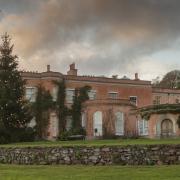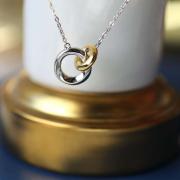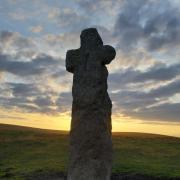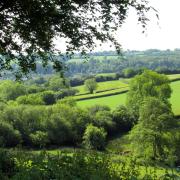Local youngsters have been helping curators at the National Trust’s Killerton House, which has an extensive fashion collection. They’ve been helping put together a new childhood fashion exhibition, so we popped along for a peek behind the scenes
Matilda Meakings is ready for her close-up. The nine-year-old schoolgirl, who would normally be engrossed in writing and maths lessons at this stage on a Wednesday morning, is instead learning about the world of fashion and photography.
She is today’s star model in a photoshoot commissioned by the National Trust to highlight their latest exhibition at Killerton House, near Exeter.

Playing by the rules: childhood, dress and imagination uses children’s clothes from Killerton’s extensive costume collection to show how kids’ clothing and dress has evolved through the ages.
The event has been curated by Killerton’s expert fashion historian Shelley Tobin with the help of a team of fashion-savvy youngsters from five local Brownie and Girl Guide groups – which is where Matilda comes in.
As a dedicated Brownie (and as the daughter of one of the exhibition organisers) she has been heavily involved in designing the artwork for the displays, as well as taking part in creative sessions to sketch the clothes of the future.

‘It was nice to do because I like drawing and I like dresses,’ says Matilda, as I grab a few minutes with her, in between photos. She’s sitting pretending to read a book in the cosy den area that’s been set up for young visitors as part of the exhibition.
‘I drew all the pictures from my own head, really,’ she adds, talking about some of the eye-catching black-and-white wall displays that have been created from her drawings. ‘I really like The Beano, so that’s what I like to draw.’
‘Just look slightly past my ear and try not to blink if you can help it,’ says National Trust (and Devon Life) photographer Steve Haywood. Like a true professional, Matilda – or Tilly as she’s better known – seamlessly switches her gaze as the flash fires.

‘That’s great, Tilly, thank you!’ says Steve, before it’s time to change outfits.
Tilly and mum Charlotte Eddington, assistant to Killerton's costume curator, disappear to get ready for the next set of pictures, which will involve posing next to a mannequin wearing a vintage Brownie Guide uniform.
Lights are set up, soft boxes positioned and there’s a slightly bizarre moment where Killerton’s house and collections manager Tom Coombe walks past carrying a pretend Brownie.
‘Just there’s fine, mate, thanks,’ says Steve, ready to take the next few shots.

I’m apparently in the way a bit, so take the opportunity to chat to Shelley Tobin, costume curator at Killerton and well-respected dress historian.
She’s responsible for organising this and many previous fashion exhibitions at Killerton, designed to showcase the nationally important costume collection here.
Past themes have included recycled fashion through the ages and sportswear. This year, Shelley and Charlotte wanted to collaborate with a new style-conscious generation.

‘We wanted to involve children as young curators,’ says Shelley. ‘Because the exhibition was about them, we felt strongly that we wanted them to be a part of putting it all together.’
Shelley and the Killerton team organised workshops with the local Brownie groups to encourage them to think about clothing of the past and future.
The youngsters were then asked to come up with a few futuristic designs that have been used as part of one of the displays.

‘They were great fun to work with and weren’t afraid to express their opinions and ideas,’ says Shelley, describing some of the clever collage and colour work that went into the designs. ‘We asked them to think about what children might be wearing in 30 years’ time,’ she explains, adding that they drew a lot of trousers and crop tops – a world away from the fussy, impractical and often uncomfortable children’s clothing of the past. ‘Some of the ideas were really, really thoughtful and took into account ideas about pollution and climate change.’
Shelley says working with her young curators was a delight and has helped her to succeed in her mission to show how attitudes to children’s fashion has changed over the centuries.

The exhibition demonstrates how small boys and girls used to be dressed almost entirely alike, even down to the petticoats. Formal Victorian clothing was often restrictive and uncomfortable. Other outfits on show here were worn for special occasions and were made from luxurious fabrics and exquisitely embroidered.
Imagine spilling an orange Fruit Shoot down your silk and gold Roman goddess Diana fancy dress outfit? This particular costume, from 1872-74, is one of the highlights of the display. Shelley has the chance to pose next to it with gloved hands during the photoshoot and the costume is due to be featured in an upcoming BBC programme. This goddess Diana dress also has another fan.
‘The Diana dress in the party room is my favourite one here,’ says Tilly, now back in her modern school uniform. ‘I like the gold on it.’
Who wouldn’t like to turn up at a party dressed as a goddess? Although, we agree some of the other pieces of formalwear look a bit too fancy, all ruffles and collars and frills (and that’s just the boys’ outfits).

‘It’s really different to our clothes but it’s nice,’ says Tilly, keen to get back to school to let her friends in Year Four know what she’s been up to today. ‘I told them what I was doing and they’ll probably ask me about it when I get back,’ she adds, before heading off with her mum.
(Charlotte had a crucial role in making the exhibition come together. As a specialist mount maker, she mounted all the costumes onto mannequins.)
Shelley gives me a quick guided tour of the rest of the displays, including a section devoted to different uniforms, school and others. Some of the children who wore these grew up to do great things. The previous wearer of the 1930s Dartmouth Naval cadet uniform, a boy called Michael Pollock, went on to become Admiral of the Fleet.
‘One of the great things about each piece of clothing is that if you know who wore it, it tells you so much about that person and that time,’ says Shelley, always researching and writing about clothes through the ages. ‘There’s always so much more to it than meets the eye. There are lots of hidden stories to tell.’
Playing by the rules: childhood, dress and imagination is at Killerton until November 3. See nationaltrust.org.uk



























